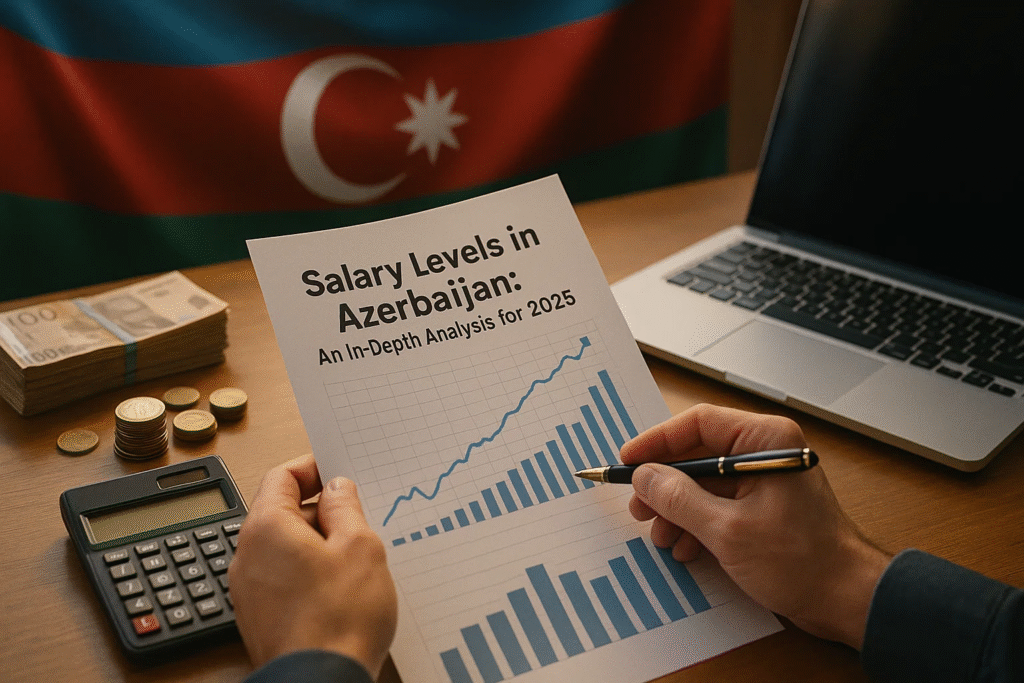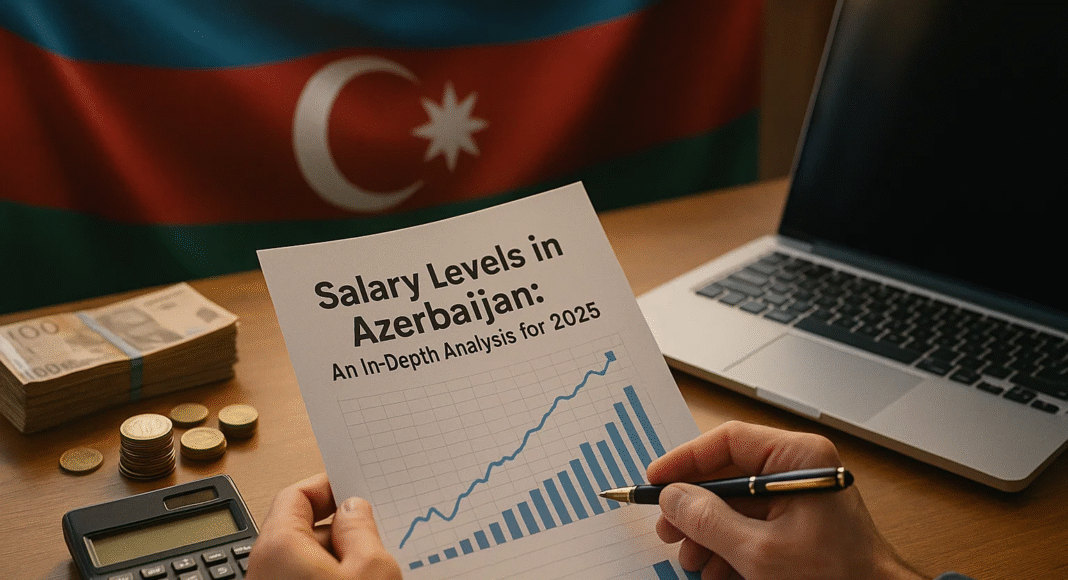Key Takeaways
- Average monthly salaries in Azerbaijan rose by approximately 10% in early 2025, driven by inflation and sectoral growth.
- Top-paying industries include IT, finance, and oil & gas, while regional wage disparities persist across cities like Baku and Nakhchivan.
- The minimum wage increased to 400 AZN in 2025, reflecting government efforts to improve living standards and income equality.
In 2025, understanding salary levels across different regions, sectors, and job roles in Azerbaijan has become increasingly important for employers, employees, policymakers, and international investors alike. As the country continues its journey through economic transformation—balancing traditional energy exports with emerging knowledge-based industries—wage dynamics are evolving rapidly. From the oil-rich fields that historically powered the nation’s GDP to the fast-growing technology hubs in urban centers like Baku, salary trends are closely tied to broader macroeconomic factors, labor market shifts, and regional development strategies. This comprehensive analysis explores how salaries in Azerbaijan are changing in 2025, offering insights grounded in official statistics, private sector data, and expert forecasts.

The year 2025 presents a unique economic landscape shaped by moderate GDP growth, inflationary pressures, and a steady labor market. Various international financial institutions have projected Azerbaijan’s GDP growth to range between 2.6% and 3.7%, depending on the source. While growth remains positive, the divergence in projections reflects underlying uncertainties, such as shifts in energy markets, global economic conditions, and regional trade disruptions. Inflation has also become a central issue, with estimates varying from 2.3% to as high as 5.7% annually. These economic indicators significantly influence wage structures, especially when employers must weigh the impact of rising living costs against business profitability.
Azerbaijan’s salary trends in 2025 are also heavily influenced by sector-specific dynamics. Industries such as information and communication technology (ICT), oil and gas, and financial services continue to offer higher-than-average compensation. In contrast, agriculture, hospitality, and manufacturing tend to fall below national wage averages. These disparities reflect both the supply-demand balance for skilled labor and the capital intensity of different industries. For instance, IT professionals and consultants command high salaries due to the global demand for digital skills, while sectors reliant on manual labor and seasonal employment exhibit slower wage growth.
Geographically, wage variations are pronounced across Azerbaijan. While Baku, as the nation’s capital and economic powerhouse, reports the highest average salaries due to its concentration of high-paying industries and international companies, regions such as Nakhchivan, Ganja, and Sumgayit offer lower wage levels. These differences are often linked to regional development priorities, cost of living, and the availability of skilled workforce. Government initiatives such as increases in the national minimum wage—from 345 AZN to 400 AZN in 2025—signal an intent to uplift income standards for low-wage earners, but real wage growth continues to depend on inflation-adjusted increases and sectoral performance.
Beyond average figures, this analysis dives deeper into the stratification of salaries by job title and experience level, shedding light on how entry-level, mid-career, and senior professionals fare across various occupations. Roles such as software developers, systems engineers, HR managers, and consultants display considerable earning differences between junior and senior levels, emphasizing the importance of experience, certifications, and skill specialization in today’s competitive job market. Moreover, evolving employment benefits, social security contributions, and severance policies further shape the total compensation landscape, influencing employee retention and job satisfaction.
This report also benchmarks Azerbaijan’s wage levels against neighboring countries such as Georgia, Armenia, and Russia. While Azerbaijan’s average monthly salary—estimated at approximately $594 in early 2025—is lower than in Russia and Georgia, it remains relatively close to that of Armenia. Such comparisons provide useful context for both multinational companies considering regional hiring strategies and domestic job seekers evaluating their earning potential.
As the Azerbaijani economy continues to diversify and modernize, salary levels will remain a critical indicator of economic health, labor market efficiency, and social equity. Whether you’re an HR professional analyzing compensation strategies, a government agency tracking labor trends, or a job seeker exploring career opportunities, this in-depth guide to salary levels in Azerbaijan for 2025 offers the insights needed to make informed decisions in a rapidly evolving economic environment.
Before we venture further into this article, we would like to share who we are and what we do.
About 9cv9
9cv9 is a business tech startup based in Singapore and Asia, with a strong presence all over the world.
With over nine years of startup and business experience, and being highly involved in connecting with thousands of companies and startups, the 9cv9 team has listed some important learning points in this overview of the Salary Levels in Azerbaijan.
If your company needs recruitment and headhunting services to hire top-quality employees, you can use 9cv9 headhunting and recruitment services to hire top talents and candidates. Find out more here, or send over an email to [email protected].
Or just post 1 free job posting here at 9cv9 Hiring Portal in under 10 minutes.
Salary Levels in Azerbaijan: An In-Depth Analysis for 2025
- Macroeconomic Overview of Azerbaijan in 2025: Implications for Salary Levels
- General Salary Trends in Azerbaijan (2025): A Detailed Analysis
- Industry-Wise Salary Breakdown in Azerbaijan (2025)
- Salary Analysis by Job Title and Experience Level in Azerbaijan (2025)
- Regional Salary Variations in Azerbaijan: A Comprehensive Outlook for 2025
- Minimum Wage and Social Benefits in Azerbaijan: A Detailed Analysis for 2025
- International Comparison of Salary Levels: Positioning Azerbaijan in the Regional Context (2025)
- Future Outlook: Salary Trajectory and Labor Market Implications in Azerbaijan (2025 and Beyond)
1. Macroeconomic Overview of Azerbaijan in 2025: Implications for Salary Levels
Understanding the macroeconomic landscape of Azerbaijan in 2025 is essential for comprehending the factors influencing wage trends across sectors. Several pivotal developments in economic growth, inflation, and labor market stability collectively shape the country’s salary trajectory. Below is an in-depth examination.
Economic Growth Projections and Salary Implications
Comparative Growth Forecasts for 2025
- A range of international and national institutions have offered differing economic growth forecasts:
- World Bank: Revised downward to 2.6%
- Ministry of Economy of Azerbaijan: Forecasts a more optimistic 3.7%
- International Monetary Fund (IMF): Projects 3.5%
- European Bank for Reconstruction and Development (EBRD): Estimates 3.0%
- Asian Development Bank (ADB): Expects 3.4%
Implications for Salary Levels
- A higher GDP growth rate, particularly the 3.7% projected by Azerbaijan’s Ministry of Economy, suggests:
- Greater business expansion and investment
- Improved corporate profitability
- Potential for upward salary adjustments, especially in fast-growing industries
- Conversely, modest growth expectations (e.g., World Bank’s 2.6%) could result in:
- Cautious salary policies by employers
- Focus on cost containment and productivity-based bonuses
Economic Momentum in Regional Context
- The South Caucasus region, including Azerbaijan, is experiencing a regional growth deceleration:
- Key drivers: Stabilization in domestic demand and a decline in oil production
- Potential for muted salary growth, particularly in oil-dependent and export-oriented sectors
Table: Economic Growth Forecasts for Azerbaijan (2025)
| Institution | GDP Growth Forecast (%) |
|---|---|
| World Bank | 2.6 |
| Ministry of Economy (Azerbaijan) | 3.7 |
| IMF | 3.5 |
| EBRD | 3.0 |
| ADB | 3.4 |
Inflationary Trends and Wage Adjustments
Current Inflationary Trends
- 2024 Average Inflation: 2.2%
- Q1 2025 Inflation: Surged to 5.6%
- Annual Forecasts:
- IMF: 5.7%
- World Bank: 2.3%
- ING Group: 5.2%
Impact on Real Wages and Cost of Living
- Rising inflation directly affects real wages and consumer purchasing power.
- Organizations are expected to:
- Implement nominal salary increases in line with projected inflation
- Offer cost-of-living adjustments (COLAs) to prevent employee attrition
- If inflation averages near 5.7% as per IMF:
- Salaries must increase by a minimum of 5–6% just to maintain real income stability
Challenges in Forecasting and Strategic Compensation Planning
- The wide range of inflation forecasts (2.3% to 5.7%) presents uncertainty:
- Employers may hesitate to commit to long-term salary hikes
- Employees face difficulties in planning personal finances
Table: Inflation Forecasts for Azerbaijan (2025)
| Institution | Projected Inflation Rate (%) |
|---|---|
| IMF | 5.7 |
| World Bank | 2.3 |
| ING Group | 5.2 |
Labor Market Dynamics and Unemployment Analysis
Unemployment Rate Trends
- April 1, 2025: Unemployment stood at 5.33%
- Total Unemployed: ~283,200 individuals
- IMF Full-Year Forecast: Slight improvement to 5.3%
Labor Market Characteristics
- Indicates a relatively balanced employment landscape
- Moderate unemployment offers:
- Stable wage competition
- Empowerment for employees to negotiate better compensation, especially in in-demand sectors
Sectoral Employment Distribution
- Public Sector Wage Employees: 878,500
- Private Sector Wage Employees: 880,300
- Near parity highlights:
- Dual importance of both sectors in shaping salary benchmarks
- Opportunities for cross-sectoral comparison and wage harmonization
Chart: Employment by Sector in Azerbaijan (2025)
Public Sector: 878,500 █████████████████████████
Private Sector: 880,300 ██████████████████████████
Opportunities and Risks
- Opportunities:
- Sectors with skills shortages may experience premium salary offers
- High-growth industries (e.g., IT, logistics, construction) likely to see wage expansion
- Risks:
- Any economic shocks—particularly in the energy sector—could lead to temporary wage freezes
- Regional instability might dampen investor sentiment, influencing employment
Conclusion: Strategic Outlook for Salaries in Azerbaijan, 2025
- Azerbaijan’s salary outlook for 2025 is closely tied to its moderate yet varied economic growth forecasts, rising inflation, and a stable labor market.
- Businesses and HR leaders are advised to:
- Monitor macroeconomic indicators quarterly
- Adjust compensation policies based on real-time inflation trends
- Maintain flexible remuneration frameworks to retain top talent
- Policymakers may need to introduce measures to protect real incomes, especially in lower-income brackets affected by inflation volatility.
2. General Salary Trends in Azerbaijan (2025): A Detailed Analysis
The dynamics of wage growth in Azerbaijan during 2025 reflect a combination of inflationary adjustments, sectoral demand shifts, and evolving labor productivity patterns. By examining nominal wage growth and sector-specific compensation distributions, one can gain deeper insights into the broader socioeconomic forces reshaping the nation’s labor market.
Average Monthly Nominal Salary Growth in Early 2025
Year-on-Year Wage Performance
- January–February 2025:
- The average monthly nominal salary was recorded at 1,043.6 Azerbaijani manats.
- This marked a year-on-year increase of 10.2% compared to the same period in 2024.
- First Quarter of 2025:
- Continued growth brought the average salary to 1,083 manats, reflecting a 10% increase over Q1 2024.
Interpretation and Implications
- These figures represent double-digit growth rates, indicative of:
- Inflation-indexed wage adjustments, ensuring the preservation of real income amidst rising prices.
- Potential improvements in labor productivity, particularly in high-demand sectors.
- Increased labor market competitiveness, possibly driven by skill shortages or elevated cost-of-living metrics.
- The marginal salary increase between January–February and the full Q1:
- Suggests a gradual upward trajectory in compensation.
- May reflect sector-specific salary uplifts or changes in labor demand occurring later in the quarter.
Table: Monthly Average Nominal Salary in Azerbaijan (2025)
| Period | Avg. Nominal Salary (AZN) | Year-on-Year Growth (%) |
|---|---|---|
| January–February 2025 | 1,043.6 | +10.2% |
| Q1 2025 (Jan–Mar) | 1,083.0 | +10.0% |
Sectoral Distribution of Higher Salaries in 2025
The Azerbaijani economy, though historically rooted in energy and resource extraction, is witnessing a gradual diversification in high-paying employment sectors. Several industries have emerged as frontrunners in terms of offering above-average compensation packages.
Top High-Paying Sectors
- Mining and Quarrying:
- Traditionally one of the highest-paid sectors, owing to:
- Strong global demand for energy exports
- High capital intensity and technical skill requirements
- Traditionally one of the highest-paid sectors, owing to:
- Financial and Insurance Activities:
- Elevated wages linked to:
- Banking reforms, modernization, and capital inflows
- Demand for qualified finance professionals, actuaries, and investment managers
- Elevated wages linked to:
- Information and Communication Technologies (ICT):
- Emerging as a core growth engine with increasing average salaries
- Growth drivers include:
- Digital transformation of government and businesses
- Regional demand for tech outsourcing and software development
- Professional, Scientific, and Technical Activities:
- Comprising jobs in engineering, consulting, architecture, and R&D
- High remuneration due to:
- Specialized expertise and STEM skill shortages
- International cooperation in knowledge-based industries
- Transportation and Storage:
- Increasing wages supported by:
- Logistics modernization and Baku’s status as a transit hub
- Growth in Caspian trade routes and infrastructure investments
- Increasing wages supported by:
Chart: High-Paying Sectors in Azerbaijan (2025)
Mining & Quarrying ████████████████████ (Top 1)
Financial & Insurance ██████████████████
ICT ████████████████
Scientific & Technical ██████████████
Transportation & Storage ████████████
Average National Salary █████████
Note: Bar height approximates relative wage level; values are indicative, not to scale.
Sectoral Wage Differentiation: Strategic Takeaways
- Consistent Outperformance:
- The above sectors outpace national averages, offering salary premiums that can exceed 20% to 50% depending on role and experience level.
- Underlying Drivers:
- Capital intensity (e.g., mining)
- Digital transformation (e.g., ICT)
- Technical complexity and innovation (e.g., scientific roles)
- Implications for Job Seekers and Policy Makers:
- Job seekers should prioritize technical upskilling and professional certifications in these high-demand industries.
- Policymakers may consider incentives to expand access to training, particularly in STEM and digital fields, to reduce skills gaps and align labor supply with economic demand.
Conclusion: Evolving Compensation Landscape in Azerbaijan
- The first quarter of 2025 illustrates a robust nominal salary expansion, driven by macroeconomic factors and sector-specific developments.
- While inflation remains a key catalyst for wage growth, labor market competitiveness and the rise of knowledge-based industries are also central to shaping compensation trends.
- High-paying sectors in Azerbaijan are no longer solely confined to resource extraction; fields like ICT, finance, and science are increasingly vital, offering sustainable and diversified pathways for income growth.
3. Industry-Wise Salary Breakdown in Azerbaijan (2025)
An examination of industry-specific salary data in Azerbaijan reveals significant variation across sectors. These disparities are influenced by a combination of economic relevance, skill intensity, technological evolution, labor market demand, and regulatory structures. Below is a detailed assessment of the compensation structures across eight key industries.
Oil and Gas Industry
Sector Overview
- As of April 1, 2025, the oil and gas sector employed roughly 31,500 individuals.
- Although sector-specific average wage figures for 2025 are not publicly disclosed, this industry is broadly recognized for offering some of the highest salaries in the Azerbaijani economy.
Key Insights
- Forms part of the mining and extractives category, historically among the top-paying industries.
- Compensation is driven by:
- Strategic national importance of energy exports
- High capital investment and technical skill requirements
Chart: Average Compensation Benchmark (Mining & Oil Sectors)
Average National Salary (Q1 2025): █████████
Mining Sector (incl. Oil & Gas): ███████████████████
Information Technology (IT) and Communication
Sector Highlights
- ICT is rapidly growing, driven by:
- Digital transformation of businesses and government
- Expansion in software engineering, data analytics, and cybersecurity
Salary Benchmarks (2025)
| Job Role | Average Annual Salary (USD) | Salary Range (USD) |
|---|---|---|
| Software Developer | $41,600 | $24,960 – $74,880 |
| Systems Engineer | $39,900 | $23,940 – $71,820 |
Key Takeaways
- Wide salary ranges highlight:
- Strong demand for experienced developers and engineers
- Entry-level roles remain accessible, while senior roles offer premium pay
Manufacturing Sector
Sector Overview
- Average monthly wage in 2023: 840.8 AZN
- 2025 Projection: ~850 AZN
- 2026 Forecast: ~875 AZN
Salary Trend Table
| Year | Avg. Monthly Salary (AZN) |
|---|---|
| 2023 | 840.8 |
| 2025 | 850 (estimated) |
| 2026 | 875 (estimated) |
Analysis
- Manufacturing salaries remain below national averages.
- Growth is gradual but consistent, indicating:
- Slow but steady industrial modernization
- Stable demand for skilled production workers
Agriculture, Forestry & Fisheries
Average Salaries
| Role | Monthly Gross Salary Range (AZN) |
|---|---|
| Agricultural Technician | 362 – 817 |
| Sector Average (2023) | 558.7 |
Key Observations
- Sector remains among the lowest-paying in Azerbaijan.
- Managerial and specialized roles (e.g., Farm Managers) command:
- Higher-than-average wages, though data is role-specific
- Compensation varies based on farm size, export volume, and specialization
Tourism & Hospitality
Salary Overview
| Position | Monthly Salary (AZN) | Notes |
|---|---|---|
| Sector Average | 723.9 (2023) | Reflects high share of entry-level roles |
| Hotel Manager | Varies | Salaries higher in international hotel chains |
| Tour Guide | N/A | 2025 data not available |
Insights
- Sector’s average wage is lower than national average, due to:
- Service-based, seasonal employment
- High turnover and limited career verticality
- However, Hotel Management roles offer:
- Competitive packages, especially in luxury brands
Finance and Insurance
Compensation Benchmarks
| Indicator | Value |
|---|---|
| Average Monthly Salary (2023) | 2,327.2 AZN |
| Comparison to National Average | 2x Higher |
Sector Strengths
- Salaries are driven by:
- Complex regulatory environments
- Demand for certified professionals (e.g., CPAs, risk analysts)
- Career paths offer quick progression and lucrative bonuses
Chart: Sector Salary vs National Average
National Avg (Q1 2025): █████████
Finance & Insurance: ██████████████████████████
Consulting Services
Average Annual Salaries
| Position | Avg. Salary (USD) | Salary Range (USD) |
|---|---|---|
| Strategy Consultant | $45,000 | $27,000 – $81,000 |
| Implementation Consultant | $31,380 | $18,828 – $56,484 |
Insights
- High compensation reflects:
- Strategic importance of business transformation
- Strong demand for cross-functional expertise
- Senior consultants enjoy international exposure and project-based bonuses
Human Resources (HR)
2025 Salary Benchmarks
| Job Role | Average Annual Salary (USD) | Salary Range (USD) |
|---|---|---|
| HR Business Partner | $32,400 | $19,440 – $58,320 |
| HR Manager | $31,400 | $18,840 – $56,520 |
Outlook
- Salaries are moderately high, with strong growth potential.
- Increased digitalization of HR systems and emphasis on employee retention are:
- Driving demand for strategic HR roles
- Elevating compensation for HR professionals with change management expertise
Conclusion: Strategic Industry Trends in Azerbaijan’s Wage Landscape (2025)
- High-paying sectors: Finance, oil & gas, ICT, and consulting remain leaders in terms of compensation due to high entry barriers and specialized skill requirements.
- Moderately paying sectors: Manufacturing, HR, and hospitality show stable wage growth, with managerial roles offering better prospects.
- Low-paying sectors: Agriculture and basic tourism roles remain at the lower end, though niche and managerial roles may break this trend.
4. Salary Analysis by Job Title and Experience Level in Azerbaijan (2025)
Understanding how compensation evolves based on professional role and career progression is vital for both job seekers and employers navigating the Azerbaijani labor market. The following analysis presents a detailed view of annual salary estimates for key professional roles, categorized by experience level — junior, mid-level, and senior. These figures reflect the influence of industry specialization, technical expertise, and management capability on wage differentiation.
Key Insights and Salary Progression Trends
General Observations
- Salaries increase significantly with experience, often doubling or even tripling from junior to senior levels.
- Fields such as software development, consulting, and HR leadership offer above-average earning potential for professionals who demonstrate domain mastery and strategic acumen.
- High-value roles tend to:
- Require technical proficiency
- Involve decision-making responsibilities
- Reward cross-functional collaboration and project execution capabilities
Estimated Annual Salary Ranges by Role and Experience (USD)
| Job Title | Junior Level | Mid-Level | Senior Level | Overall Average |
|---|---|---|---|---|
| Software Developer | $24,960 – $33,280 | $33,280 – $49,920 | $49,920 – $74,880 | $41,600 |
| Systems Engineer | $23,940 – $31,920 | $31,920 – $47,880 | $47,880 – $71,820 | $39,900 |
| Strategy Consultant | $27,000 – $36,000 | $36,000 – $54,000 | $54,000 – $81,000 | $45,000 |
| Implementation Consultant | $18,828 – $25,104 | $25,104 – $37,656 | $37,656 – $56,484 | $31,380 |
| HR Business Partner | $19,440 – $25,920 | $25,920 – $38,880 | $38,880 – $58,320 | $32,400 |
| HR Manager | $18,840 – $25,120 | $25,120 – $37,680 | $37,680 – $56,520 | $31,400 |
Role-Based Salary Breakdown
Software Developer
- Among the highest-earning roles in Azerbaijan’s IT landscape.
- Earning trajectory reflects:
- Rapid career progression
- Strong global demand for coding, backend, and frontend development
- Senior developers can command salaries close to $75,000 annually, especially with specialized skills (e.g., AI, DevOps, cloud infrastructure)
Systems Engineer
- Compensation closely tracks with software development roles but slightly lower.
- Mid-career engineers earn up to $47,880, with scope for growth into architecture or IT management roles.
- Senior engineers specializing in network security or enterprise infrastructure command top-tier salaries.
Strategy Consultant
- Offers a broad salary band, ranging from $27,000 to $81,000, depending on:
- Industry served (finance, energy, government)
- Scope of engagement (local vs international projects)
- Senior consultants are rewarded for:
- Analytical depth
- Leadership in transformation initiatives
Implementation Consultant
- Lower base than strategy consultants, but strong growth trajectory.
- Compensation reflects:
- Project execution proficiency
- Client-facing experience
- Senior professionals can exceed $55,000/year in high-demand industries such as tech, logistics, or ERP rollouts.
HR Business Partner
- Strategic HR roles such as HRBPs bridge business and people management.
- Senior HRBPs are increasingly valued for:
- Data-driven decision making
- Organizational change management
- Compensation tops $58,000, reflecting their business-critical advisory functions.
HR Manager
- Slightly narrower salary band compared to HRBPs.
- HR Managers remain central to:
- Operational excellence
- Policy compliance
- Employee engagement
- Career growth may lead to roles like Head of HR or HR Director, with higher salary potential not captured in this chart.
Chart: Salary Range by Role and Experience Level (USD)
plaintextCopyEditRole | Junior | Mid-Level | Senior
---------------------------------------------------------------
Software Developer | ████████ | ███████████ | █████████████████
Systems Engineer | ███████ | █████████ | ████████████████
Strategy Consultant | █████████ | ███████████ | ███████████████████
Implementation Consultant | █████ | ███████ | ██████████████
HR Business Partner | █████ | ███████ | ███████████████
HR Manager | █████ | ███████ | ██████████████
Note: Bar height visually reflects comparative salary levels across roles and experience bands. Scale is proportional.
Conclusion: Salary Growth Linked to Experience and Strategic Role Positioning
- The Azerbaijani labor market in 2025 strongly rewards experience, specialization, and industry relevance.
- Professionals can significantly enhance their earnings by:
- Upskilling in high-demand technologies
- Gaining certifications relevant to their field (e.g., PMP, SHRM, AWS)
- Seeking roles with strategic business alignment
- Employers are encouraged to:
- Benchmark compensation using up-to-date market data
- Foster career progression frameworks to retain top talent
5. Regional Salary Variations in Azerbaijan: A Comprehensive Outlook for 2025
Salary levels in Azerbaijan display notable disparities across regions, driven by a combination of economic concentration, industrial specialization, cost of living, and urbanization. The capital city, Baku, consistently outperforms in terms of average income, while outlying regions such as Nakhchivan and smaller cities like Lankaran report comparatively lower wage figures. This section provides a regional breakdown, supported by recent data and contextualized through cost-of-living comparisons.
Regional Salary Trends in 2025: Key Findings
National Benchmark
- National Average Monthly Salary (Q1 2025): 1,083 AZN (approx. $637.16 USD)
- Serves as the reference point for evaluating regional discrepancies.
Regional Salary Comparison Table
| Region/City | Avg. Monthly Salary (AZN) | USD Equivalent | % Difference from National Avg | Estimated Cost of Living (USD) |
|---|---|---|---|---|
| Baku (Jan–Nov 2024) | 1,255.5 | ~$738.75 | +15.9% | ~$600–$750 |
| Nakhchivan (Q1 2025) | 817.8 | ~$481.06 | –24.5% | ~$450 |
| National Average (Q1 2025) | 1,083 | ~$637.16 | Baseline | ~$500–$650 |
| Ganja (Est. post-15% hike) | N/A | N/A | Unspecified due to missing base | ~$470 |
| Sumgayit | N/A | N/A | Unavailable | ~$453 |
| Lankaran | N/A | N/A | Unavailable | Not specified |
| Yevlakh | N/A | N/A | Unavailable | ~$356 |
Baku: The Capital City and Salary Leader
Economic Characteristics
- Baku remains Azerbaijan’s primary financial, political, and commercial hub.
- Hosts the headquarters of multinational companies, oil and gas conglomerates, and international financial institutions.
Salary Observations
- Average Monthly Salary: 1,255.5 AZN (as of Jan–Nov 2024)
- ~16% higher than the national average
- Reflects high-paying sectors:
- Energy (oil & gas)
- Finance and insurance
- IT and communications
- Corresponds with a higher cost of living, which drives employers to offer more competitive wage packages.
Nakhchivan: Subdued Salary Levels with Lower Living Costs
Overview
- A semi-autonomous exclave, Nakhchivan demonstrates lower average salary levels.
- Average Monthly Salary (Q1 2025): 817.8 AZN (~$481.06)
Factors Influencing Lower Wages
- Lower economic activity in capital-intensive industries
- Dominance of agriculture and public sector employment
- Limited presence of international business operations
Cost of Living Context
- Moderately lower than national average, aiding in maintaining purchasing power parity
Ganja: Emerging Industrial and Academic Center
Key Developments
- Staff at public institutions, including the Ganja Branch of the National Academy of Sciences, received a 15% salary increase, effective January 1, 2025.
- While base salaries were not specified, the move reflects public investment in regional academic infrastructure.
Cost of Living
- Estimated at $470/month, slightly below the national average, which supports modest wage levels.
Sumgayit and Other Regional Cities: Wage and Cost Divergence
Sumgayit
- One of Azerbaijan’s largest industrial cities, especially known for chemical manufacturing and metallurgy.
- Estimated cost of living: $453/month
- Salary data not specified, but expected to be below Baku levels and potentially near the national average.
Yevlakh
- Smaller city with a more agricultural and administrative economy.
- Estimated monthly cost of living: $356, among the lowest recorded, indicating lower salary expectations.
Lankaran
- Located in southeastern Azerbaijan.
- Salary figures not specified.
- Cost of living data unavailable, but inferred to be modest based on regional norms.
Visual: Regional Salary Index vs Cost of Living
plaintextCopyEditRegion | Salary Index (Nat. Avg = 100) | Cost of Living Index (Nat. Avg = 100)
-----------------------------------------------------------------------------------------
Baku | ████████████████ (116) | ██████████████ (115)
Nakhchivan | ██████████ (75.5) | █████████ (90)
Ganja | ███████████ (Est. 90–100) | ██████████ (94)
Sumgayit | ███████████ (Est. 95) | ██████████ (92)
Yevlakh | █████████ (Est. 85) | ████████ (71)
Note: Salary Index and Cost of Living Index are scaled based on estimated or known data, with 100 representing the national average.
Conclusion: Regional Salary Disparities in 2025
- Urban-rural wage gap remains pronounced in Azerbaijan, mirroring broader global trends.
- Baku continues to dominate in terms of salary levels, supported by industry concentration and international presence.
- Nakhchivan, Ganja, and secondary cities offer lower salary bands, but with commensurately reduced living expenses, preserving relative affordability.
- Strategic regional economic development initiatives, particularly in infrastructure, education, and local industry, are likely to narrow wage gaps in the coming years.
6. Minimum Wage and Social Benefits in Azerbaijan: A Detailed Analysis for 2025
As Azerbaijan’s labor market continues to evolve in 2025, the government has implemented new reforms to strengthen the social protection of workers, ensure financial stability for low-income earners, and maintain competitiveness across employment sectors. Understanding the implications of changes in minimum wage legislation and the structure of employer and employee contributions is crucial for interpreting the broader compensation environment.
Minimum Wage Policy Developments
Overview of the 2025 Minimum Wage Reform
- Effective Date: January 1, 2025
- New Minimum Wage: 400 AZN/month
- Equivalent to approximately $235 USD (as per prevailing exchange rates)
Key Implications
- Represents a significant policy measure aimed at improving income sufficiency among the country’s lowest-paid employees.
- Reflects the government’s social commitment to inclusive economic growth, especially amid rising inflation and living costs.
- May serve as a benchmark for negotiating wage adjustments in adjacent low-income occupational categories.
Market-Wide Impact
- Can indirectly influence:
- Private sector salary structures for entry-level or semi-skilled roles
- Public sector compensation alignment
- Consumer purchasing power and inflationary trends
Social Security and Mandatory Contributions in 2025
Understanding the mandatory contributions framework in Azerbaijan is essential for employers, HR professionals, and employees seeking clarity on net income and social insurance entitlements.
Employer Contributions (Private Sector)
| Contribution Type | Rate | Coverage |
|---|---|---|
| Social Security (Unified) | 17.5% of gross income | Pensions, disability, general welfare |
| Mandatory Health Insurance | 2% of gross income | Universal healthcare access |
- These contributions are compulsory and form part of the total employment cost for businesses.
- Intended to guarantee long-term retirement income, healthcare protection, and basic social welfare rights.
Employee Contributions (Private Sector)
| Contribution Type | Income Range | Rate |
|---|---|---|
| Social Security | Up to 200 AZN | 3% |
| Above 200 AZN | 10% on excess + fixed sum | |
| Mandatory Health Insurance | Up to 8,000 AZN | 2% |
| Above 8,000 AZN | 0.5% + fixed monthly sum |
- Deductions are made directly from monthly gross salaries.
- Ensures employees maintain access to healthcare services and accumulate pensionable earnings.
Severance Pay: Statutory Protections
Termination Benefits under Azerbaijani Labor Law
- Employers are legally obligated to provide severance pay upon the termination of employment.
- Severance is scaled according to tenure, ensuring fair compensation for long-serving employees.
General Framework
- Length of Service:
- Typically influences the multiplier of final salary (e.g., one month’s wage per service year)
- Applicability:
- Enforced in redundancy cases, organizational restructuring, or contract terminations not caused by employee misconduct
Summary Matrix: Minimum Wage and Social Contributions (2025)
| Element | Employer | Employee | Effective in 2025 |
|---|---|---|---|
| Minimum Monthly Wage | N/A | N/A | 400 AZN |
| Social Security Contribution | 17.5% of gross wage | 3% (up to 200 AZN), 10% thereafter | Mandatory |
| Mandatory Health Insurance | 2% of gross wage | 2% (up to 8,000 AZN) | Mandatory |
| Severance Pay | Based on tenure (as per law) | N/A | Mandated upon termination |
Implications for Employers and Workers
For Employers
- Must account for 20–21% overhead in addition to base salary costs.
- Need to ensure compliance with:
- Minimum wage legislation
- Contribution remittance timelines
- Employment contract provisions regarding severance
For Employees
- Actual net take-home pay is reduced by statutory contributions but provides:
- Access to retirement income
- Public medical coverage
- Legal job protection rights
For Policymakers and Analysts
- These measures are critical to:
- Assessing economic resilience
- Evaluating labor market equity
- Projecting future pension fund sustainability
7. International Comparison of Salary Levels: Positioning Azerbaijan in the Regional Context (2025)
As global labor markets evolve, comparative salary benchmarking provides essential insights into a country’s economic maturity, cost of living, and workforce competitiveness. In early 2025, Azerbaijan’s average monthly wage stood at $594 USD, positioning the country below several of its regional neighbors in terms of gross income, while remaining broadly aligned with nations of comparable economic complexity.
This section explores how Azerbaijan’s salary landscape measures against peer countries—namely Armenia, Georgia, Russia, and Turkey—offering a contextual lens for employers, employees, and policymakers navigating regional talent dynamics.
Comparative Monthly Earnings: Azerbaijan vs Neighboring Countries
Overview of Regional Wage Indicators
- Variations in average monthly salaries reflect:
- Differences in economic productivity
- Levels of industrial diversification
- Degree of urbanization
- Variations in social benefits and tax structures
- Currency strength and inflation control
Table: Regional Comparison of Average Monthly Gross Salaries (in USD)
| Country | Latest Available Period | Average Monthly Salary (USD) | Comparison to Azerbaijan |
|---|---|---|---|
| Azerbaijan | January 2025 | $594 | Baseline |
| Armenia | June 2023 | $692 | +16.5% |
| Georgia | September 2024 | $758 | +27.5% |
| Russia | December 2024 | $1,256 | +111.4% |
| Turkey | N/A | Not available | N/A |
Note: All figures represent gross earnings and are based on official statistical sources or latest available international labor data.
Visual Chart: Average Monthly Earnings Across Select Countries
plaintextCopyEditCountry | Salary (USD)
---------------------------
Russia | ████████████████████████████ $1,256
Georgia | ████████████ $758
Armenia | ██████████ $692
Azerbaijan | ████████ $594
Turkey | Data unavailable
Bar lengths scaled relative to Russia (highest available benchmark).
Interpretation and Implications
Positioning of Azerbaijan
- Lower than Georgia and Armenia:
- Indicates room for wage growth in key sectors such as IT, finance, and services.
- May impact cross-border labor mobility, especially in border regions or among remote workers.
- Significantly behind Russia:
- Reflects Russia’s larger economy, stronger industrial base, and resource-driven earnings.
- Highlights Azerbaijan’s need to diversify economic outputs and elevate value-added job creation.
Armenia and Georgia’s Wage Context
- Armenia:
- Slightly ahead of Azerbaijan; driven by IT outsourcing, financial remittances, and public sector modernization.
- Georgia:
- Higher salaries reflect growth in tourism, logistics, and foreign investment-friendly reforms.
Russia:
- More than double Azerbaijan’s average salary.
- Backed by:
- Strong energy exports
- Larger urban labor markets (e.g., Moscow, St. Petersburg)
- Higher cost of living and taxation levels
Factors Driving Regional Disparities
| Determinant | Azerbaijan | Armenia/Georgia | Russia |
|---|---|---|---|
| Economic Complexity | Moderate | Moderate | High |
| Labor Market Flexibility | Improving | Flexible | Mixed (varies by region) |
| Industrial Specialization | Energy, Construction, Services | Services, IT, Tourism | Energy, Manufacturing, Services |
| Currency Stability | Stabilized post-2022 | Moderate volatility | Managed depreciation |
| Cost of Living | Moderate | Moderate | High (especially in urban centers) |
Conclusion: Azerbaijan’s Salary Benchmark in a Regional Framework
- In 2025, Azerbaijan’s average wage places it below regional leaders in income terms, though not significantly out of step with similarly structured economies.
- As the country advances economic reforms, attracts foreign investment, and emphasizes ICT and SME development, salaries are expected to rise gradually in alignment with productivity gains.
- To remain competitive regionally:
- Policymakers must continue investing in education, upskilling, and digital infrastructure.
- Employers must benchmark wages against regional peers to attract and retain top-tier talent.
8. Future Outlook: Salary Trajectory and Labor Market Implications in Azerbaijan (2025 and Beyond)
The trajectory of wage development in Azerbaijan during 2025 presents a multifaceted picture of a nation in transition—balancing between inflationary pressures, sector-specific growth, and government-led socio-economic interventions. Understanding these dynamics is critical for both domestic stakeholders and international observers assessing Azerbaijan’s evolving labor market.
Key Trends Shaping Azerbaijan’s Salary Landscape in 2025
General Wage Growth and National Benchmarks
- The average nominal monthly salary increased by approximately 10% year-on-year during the first quarter of 2025.
- This sustained growth reflects:
- Increased labor demand in critical sectors
- Inflation-adjusted wage recalibrations
- Government commitment to elevating income standards
Sectoral Leaders in Compensation
- Industries with the highest reported salary levels continue to include:
- Oil and Gas: Driven by legacy investments and export dynamics.
- Information Technology: A rapidly expanding sector attracting local and international capital.
- Finance and Insurance: Benefiting from sectoral modernization and skilled labor demand.
Geographical Wage Disparities
- Baku consistently leads the nation with above-average salaries, attributed to:
- High concentration of corporate headquarters
- Presence of multinational firms and financial institutions
- Elevated urban cost of living
- Nakhchivan Autonomous Republic and other secondary regions exhibit lower wage averages, reflecting more modest economic activity and differing industrial bases.
Minimum Wage Reform
- The statutory minimum wage was raised to 400 AZN/month in January 2025.
- Aimed at reducing income inequality
- Expected to influence wage floors across low-income professions
Table: Key Influences on Future Salary Adjustments (2025)
| Factor | Impact on Salaries | Strategic Implications |
|---|---|---|
| Moderate GDP Growth (2.6–3.7%) | Supports gradual wage expansion in stable sectors | Need for targeted incentives in lagging regions/sectors |
| Rising Inflation (forecast 5.2–5.7%) | Necessitates nominal salary increases to maintain real income | Wage adjustments must keep pace with cost-of-living changes |
| Expansion of ICT sector | Drives demand for high-skilled professionals | Increased competition for talent; wage bidding expected |
| Government-led wage reform | Lifts baseline income standards | Signals stronger labor protections, boosts domestic consumption |
| Regional disparities | Highlight income inequality by geography | May necessitate regional wage balancing and public policy intervention |
Emerging Trends and Forward-Looking Scenarios
Information Technology as a Long-Term Driver
- The IT sector is poised to become a primary engine of wage growth due to:
- Digital transformation initiatives
- Rising interest from foreign tech investors
- Governmental focus on STEM education and digital upskilling
Inflation as a Wage Pressure Catalyst
- With inflation averaging between 5.2% and 5.7% in early 2025:
- Employers must continuously review salary scales to maintain competitiveness.
- Workers will expect real wage preservation, especially in urban centers.
Regional Policy Adjustments and Labor Equity
- The wage gap between urban and rural regions necessitates:
- Decentralized economic development programs
- Infrastructure investment to stimulate high-paying employment outside of Baku
- Enhanced data collection on local salary trends
Recommendations for Future Research and Policy
For Policymakers and Analysts
- Undertake real wage growth analysis by factoring in inflation-adjusted metrics.
- Collect and disseminate quarterly salary data across all major industries and regions.
- Monitor the efficacy of the minimum wage in improving household consumption.
For Employers
- Benchmark salaries against regional competitors to avoid talent attrition.
- Introduce performance-based compensation in sectors where salary caps persist.
- Adjust HR strategies to accommodate hybrid work models and remote talent sourcing.
For Job Seekers and Employees
- Focus on high-growth sectors such as ICT, finance, and consulting.
- Invest in continuous learning to command higher wages in emerging industries.
- Consider geographic relocation to urban hubs where earning potential is significantly higher.
Chart: Sector Outlook for High-Earning Potential (2025–2027)
plaintextCopyEditSector | 2025 Avg Salary | Projected Growth (%) | Outlook
------------------|------------------|-----------------------|----------------------
IT & Software | $41,600 | 10–12% | High growth, high demand
Finance & Insurance| $27,000–$81,000 | 8–10% | Stable, skill-intensive
Oil & Gas | Est. >$50,000 | 3–5% | Stable, resource-dependent
Consulting | $31,380–$45,000 | 6–9% | Moderate growth
Manufacturing | $10,200 | 2–4% | Slow, labor-intensive
Agriculture | $6,600 | 1–3% | Low, regionally varied
Conclusion: Navigating Azerbaijan’s Salary Evolution in 2025 and Beyond
Azerbaijan’s salary ecosystem in 2025 reflects an economy at a crossroads—balancing traditional industries like energy with emerging sectors such as information technology. With inflationary dynamics and regional income disparities shaping wage strategies, both public and private stakeholders must adopt data-driven, inclusive compensation policies. The continued rise in nominal wages, sector-specific wage divergence, and enhanced social protections signal a cautiously optimistic outlook for the Azerbaijani workforce.
Conclusion
The evolving salary landscape in Azerbaijan in 2025 paints a nuanced picture of a nation in economic transition, influenced by macroeconomic shifts, regional dynamics, sector-specific performance, and global labor trends. This in-depth analysis reveals that while Azerbaijan continues to register consistent growth in nominal wages, several underlying factors must be considered to truly understand the state of compensation and labor market health across the country.
One of the most significant developments in 2025 is the steady year-on-year increase in average nominal salaries, which have grown by approximately 10% during the first quarter of the year. This robust upward trend underscores the country’s efforts to align wage levels with rising inflation and the increasing cost of living, while also responding to heightened demand for talent in high-growth sectors such as information technology, finance, and oil and gas. The consistent growth in wages signals a maturing economy that is gradually shifting from dependence on natural resources to a more diversified, service- and knowledge-based labor market.
Sectoral disparities remain a defining characteristic of Azerbaijan’s salary structure in 2025. The oil and gas industry continues to offer some of the most competitive compensation packages, driven by its strategic role in the national economy. However, the rapid emergence of the ICT sector as a top-paying industry illustrates a shift in the country’s employment patterns, highlighting the increasing value of digital and technical skills in the Azerbaijani labor market. Finance, consulting, and specialized professional services also continue to outperform traditional sectors such as agriculture, manufacturing, and hospitality in terms of average compensation, reflecting a broader global trend towards high-skill, high-reward employment sectors.
Regional wage variations are another key aspect of the 2025 salary ecosystem. Baku, as the administrative and economic nucleus of the country, continues to record the highest average salaries, bolstered by the presence of multinational corporations, international organizations, and financial institutions. In contrast, regions such as Nakhchivan and secondary cities like Ganja and Lankaran tend to exhibit lower average wages, largely due to differing levels of industrialization, economic development, and cost of living. These disparities underscore the importance of regional development policies and investment strategies that aim to equalize economic opportunities across the country.
The government’s decision to raise the minimum wage to 400 manats per month in January 2025 reflects a broader strategy aimed at enhancing living standards, promoting income equality, and stimulating domestic demand. This initiative, alongside employer and employee contributions to social security and healthcare, forms the foundation of Azerbaijan’s evolving compensation framework. As these measures take effect, they are likely to influence wage floors across various sectors, particularly in low-income and service-oriented occupations.
From a macroeconomic perspective, salary trends in 2025 are being shaped by a combination of moderate GDP growth—projected between 2.6% and 3.7%—and relatively high inflation, forecasted between 5.2% and 5.7%. This economic context places pressure on employers to continually evaluate and adjust their compensation strategies in order to maintain employee purchasing power and avoid talent attrition. The interplay between inflation and wage growth will be crucial in determining the real income trajectory of Azerbaijani workers throughout the year.
International comparisons further contextualize Azerbaijan’s wage position. With an average monthly income of approximately $594 USD in early 2025, Azerbaijan lags behind regional peers such as Georgia, Armenia, and significantly behind Russia. While these disparities are influenced by numerous factors—including economic complexity, industrial base, and urbanization levels—they highlight the need for Azerbaijan to accelerate reforms in education, innovation, and workforce development to remain regionally competitive.
Looking ahead, several themes will define the future of salary dynamics in Azerbaijan:
- Digital transformation will continue to reshape the labor market, increasing demand for skilled professionals in IT, cybersecurity, software development, and digital finance.
- Education and upskilling will become increasingly critical, as both employers and employees must adapt to the demands of a rapidly evolving economy.
- Policy innovation will be necessary to close regional wage gaps, improve income equality, and ensure inclusive economic growth.
- Real wage analysis—adjusted for inflation—will become essential in assessing the true progress of worker welfare in the country.
In conclusion, Azerbaijan’s salary landscape in 2025 reflects a country at the crossroads of tradition and transformation. With steady progress in wage growth, emerging high-income sectors, and bold policy moves to uplift the lower-income population, the foundations are being laid for a more balanced and prosperous labor market. However, sustained improvement will require a multi-pronged approach—driven by private sector innovation, public sector foresight, and a workforce that is empowered with the skills and flexibility needed to thrive in an increasingly competitive global economy.
If you find this article useful, why not share it with your hiring manager and C-level suite friends and also leave a nice comment below?
We, at the 9cv9 Research Team, strive to bring the latest and most meaningful data, guides, and statistics to your doorstep.
To get access to top-quality guides, click over to 9cv9 Blog.
People Also Ask
What is the average monthly salary in Azerbaijan in 2025?
The average monthly nominal salary in Azerbaijan in early 2025 is approximately 1,083 AZN, reflecting a 10% year-on-year increase.
Which sectors offer the highest salaries in Azerbaijan in 2025?
The top-paying sectors include information technology, oil and gas, finance, consulting, and telecommunications.
What is the minimum wage in Azerbaijan in 2025?
As of January 2025, the minimum wage in Azerbaijan is set at 400 AZN per month.
How do salaries in Baku compare to other regions in Azerbaijan?
Salaries in Baku are significantly higher than in other regions, driven by a concentration of high-paying industries and a higher cost of living.
Are salaries in Azerbaijan increasing in 2025?
Yes, nominal salaries have increased by about 10% in early 2025, driven by inflation, productivity gains, and economic growth.
What is the average salary for IT professionals in Azerbaijan in 2025?
Software developers earn an average of $41,600 annually, with salaries ranging from $24,960 to $74,880 based on experience.
How much does a Systems Engineer earn in Azerbaijan in 2025?
The average annual salary for a Systems Engineer is around $39,900, depending on experience level.
What is the salary range for consultants in Azerbaijan?
Strategy consultants earn between $27,000 and $81,000 per year, while implementation consultants earn $18,828 to $56,484.
What are typical HR salaries in Azerbaijan in 2025?
HR Business Partners earn an average of $32,400 annually, while HR Managers earn around $31,400, varying by experience.
Is the manufacturing sector in Azerbaijan well-paid in 2025?
The average monthly salary in manufacturing is about 850 AZN in 2025, which is below the national average.
What are average salaries in the agricultural sector in Azerbaijan?
Salaries in agriculture are among the lowest, with monthly averages between 362 AZN and 817 AZN for most technical roles.
What is the average income in the hospitality sector in 2025?
The average salary in accommodation and food services is around 724 AZN, with higher wages for hotel management roles.
How much do finance professionals earn in Azerbaijan?
The average monthly salary in finance and insurance is 2,327 AZN, making it one of the highest-paying sectors.
How does Azerbaijan’s average salary compare to neighboring countries?
Azerbaijan’s average monthly salary of $594 is lower than Georgia and Armenia, and significantly lower than Russia.
What is the impact of inflation on salaries in Azerbaijan in 2025?
With inflation forecasted at 5.7%, salary increases are essential to preserve real purchasing power for workers.
How many people work in the oil and gas sector in 2025?
Approximately 31,500 individuals are employed in Azerbaijan’s oil and gas industry as of April 2025.
Is there a difference between public and private sector salaries?
Yes, public sector wages are often lower than those in private industries like IT, finance, and consulting.
What is the unemployment rate in Azerbaijan in 2025?
As of April 2025, the unemployment rate stands at around 5.33%, reflecting a relatively balanced labor market.
How are social contributions calculated for employees in Azerbaijan?
Employees contribute 3–10% of income to social security and 2% to medical insurance, depending on salary brackets.
What are the employer contributions in Azerbaijan?
Employers contribute 17.5% of gross income to social security and an additional 2% to medical insurance.
Do regional cities like Ganja and Sumgayit have lower salaries?
Yes, these cities generally have lower salary levels compared to Baku, reflecting regional economic differences.
What is the cost of living in Baku compared to salary levels?
While Baku has higher salaries, it also has a higher cost of living, which impacts real income and purchasing power.
How do wages in Azerbaijan reflect economic growth in 2025?
Wages are rising moderately in line with GDP growth projections of 2.6% to 3.7%, depending on the source.
What role does the IT sector play in Azerbaijan’s wage growth?
The IT sector is a key driver of wage growth, offering competitive salaries and attracting skilled professionals.
What is the forecast for real wage growth in Azerbaijan?
Real wage growth depends on salary adjustments relative to inflation, with modest gains expected if inflation stays controlled.
Are salary increases uniform across all industries?
No, salary increases are more significant in high-demand industries like IT and finance, while traditional sectors see slower growth.
What are the income expectations for agricultural managers in 2025?
Income for farm managers varies widely, depending on the type and size of agricultural operations.
What is the estimated monthly cost of living in Ganja?
The monthly cost of living in Ganja is approximately $470, lower than Baku’s but reflective of its wage structure.
How do salaries correlate with experience level in Azerbaijan?
Salaries increase significantly with experience, especially in IT, HR, and consulting, where senior roles earn over double junior ones.
What is the long-term outlook for salaries in Azerbaijan?
The outlook is cautiously optimistic, with gradual increases expected, especially in tech and professional services.
Sources
Respublika News
Trend News Agency
AzerNews
CEIC Data
Caucasus Watch
Aze.Media
Wise
APA News Agency
Caliber
IMF eLibrary
International Monetary Fund (IMF)
Turkic World
Azerbaijan24
Playroll
Jobicy
WageIndicator Foundation
State Statistical Committee of the Republic of Azerbaijan
Anews
Trading Economics
Report
Paylab
ZipRecruiter
WorkBC
JAMnews
Multiplier
Skuad
Remote People
Take-Profit
Neeyamo
Salary.com
PayScale
Leverage Edu






























![Writing A Good CV [6 Tips To Improve Your CV] 6 Tips To Improve Your CV](https://blog.9cv9.com/wp-content/uploads/2020/06/2020-06-02-2-100x70.png)


